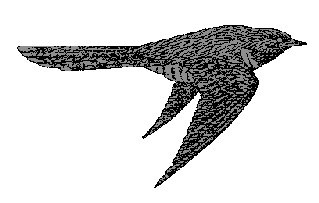Mäetagused vol. 3
Summary
Forty Birds in Estonian Folk Belief II

Mall Hiiemäe
Seagulls (Larus) were in the old times thought to be the souls~spirits of
drowned sailors. By their behaviour, weather has been forecasted, especially in
the areas near the shore (see the map). Peewits (Vanellus vanellus) was
thought to have been used to find hiding people in the ancient wars because of
its chirping sound and aggressive voice (the call: here's one!). a touch with the
egg of a wheatear (Oenathe oenathe) was believed to have a bad influence
on one's skin. The dove (Columba livia) has an image of special
protectiveness maybe because of Christian influences. Hawks (Falnicormes)
have, according to the legend, been made by Jude or the devil; a demon-like
forest-fairy of the devil may appear as a hawk. Hawks as well as owls were nailed
to the stallion doors for protection against witchcraft and nightmares. With the
crucifixion of Jesus, legends about the structure of the beak of the crossbills
(Loxia), and the red hue in the feathers of chaffints (Fringiela
coelebs), redstart (Phoenicurus Roenicurus), etc. The cuckoo (Cuculus
canorus) is the most popular bird in Estonian folk belief. To the fairy-tale
AT 720 ("The orphan as a cuckoo«) is added or exists separately a song.
Smaller birds have been considered to be the feeders~servants of the cuckoo; the
cuckoo singing near the house is thought to be an omen of death also today.
A Brief Outline of Contemporary Neo-Paganism in the West
Ergo-Hart Västrik
Neo-Paganism can be considered as a marginal cultural and religious phenomenon in a
modern society. This article which is mostly based on the sources available in
Internet, gives a brief overview of the Neo-Paganism in the English speaking West,
particularly in the United States where Neo-Pagan groupings have declared their
views widely in World Wide Web. The present article will address some characteristics
of the movement, facts about the development of the different groups, as well as
their similarities and differences.
A modern western society of today can be characterized as post-religious or
post-Christian as in comparison with preceding periods of time an increasing
secularization is underway. Religion is substituted by the other aspects of
modern life, e.g. traits of cult and religion can be observed in politics, popular
sub-cultures and mass media. On the other hand, modern time is characterised as an
era of science, a triumph of secularism and rationalism. One may think that the
decrease of the religious dominant on everyday life and society in general has,
in turn, increased the interest in alternative spiritual and religious movements.
The tendency is reflected in the formation and spread of the religious movements
of Oriental origin, various Christian and non-Christian denominations and
multifarious other new religious movements of different and mixed origins. All
the trends can be characterised with a goodwill to understand the world and live
differently from how it has been in earlier times, so that to complement the
mainstream of Christianity, provide the alternative to atheism or any other
tendency in the society.
Modern Neo-Paganism is usually classified as one of the abovementioned new
religious movements coming to public attention in West-European and North-American
countries since the 1960s. The term Neo-Paganism do not signify any
homogenous trend or movement, but is used as an universal appellation for a
variety of alternative movements (from neo-shamanism to women's spirituality
circles). In general Neo-Paganism is defined as spiritual movement that attempts
to revive the ancient polytheistic religions of Europe and Middle East. Different
movements carry out the process of revival in diverse ways, as the teachings of
the Neo-Pagan groups are based on different sources such as:
(1) ancient ethnic or local traditions (e.g. Celtic, Germanic, Mediterranean);
(2) modern written sources (e.g. anthropological theories, fiction, books of
alternative spirituality that are treated as cult-books within a certain grouping);
and
(3) alternative movements and teachings in society (e.g. occultism, freemasonry,
anthroposophy, new age, feminism, green movement).
The sources mentioned above are included in the teaching of the particular grouping
separately, two at time or all together. We may distiguish the groupings that:
(a) follow certain "pure« well-documented tradition or form of religion
that has existed in ancient times (e.g. Druidists, Asatruars, Hellens)
(b) combine the religious elements and traditions of different origin as well as
modern ideas (e.g. different forms of Wicca);
(c) synthesize a new universal and abstract Pagan religion out of the aforementioned
sources (e.g. Church of All Worlds).
Neo-Paganism in Europe and North-America after the World War II, has been largely
influenced by the occult movements and interest towards the European magic and
witchcraft (Wordsworth... 1995). It is closely related to the activities
of British civil servant Gerald Bosseau Gardner (1884-1962) who published in 1954,
three years after the repeal of last British Witchcraft law, a book Witchcraft
Today. Gardner popularized a theory of anthropologist Margaret Murray according
to which witchcraft had existed since the pre-Christian times in small, scattered,
occult groups practicing old pagan religion (Melton 1989: 142, Clark 1994). Typical
of the ideas of Gardner and Murray was to see whichcraft as an ancient religion;
thus the activities and rituals of witches were not, according to their ideas,
focused to the Evil One, but horned deity of fertility. Gardner tried to change
the public opinion towards the witches known in the past as well as show that the
cult of witches is still existing. He considered himself to be the successor of
the ancient witches and founded with the group of enthusiasts a movement named
Wicca. The adherents of Wicca formed several covens, basic groups of modern
witches, in Britain and soon the movement spread to English-speaking North-America.
The term Neo-Paganism was introduced to the public through the writings of
Tim Zell, known also as Ottter G'Zell, who is the founder of Church of All Worlds (CAW),
one of the most well-known and widespread Neo-Pagan organisations in the United
States (Melton 1989: 145). Zell was familiar with the Wiccan ideas but main
mythological patterns of the CAW are based on the Robert Heinlein's science fiction
Stranger in a Strange Land. CAW was the first Neo-Pagan organisation to
obtain full Federal recognition in the United States in 1968. According to the
ideology of CAW, Neo-Paganism is a revival and reconstruction of ancient Nature
religions adapted for the modern world. CAW is typical example of the new religious
movement that is combining elements of different cultures and spiritual disciplines.
At the same time, the ideology of CAW is focused on the topics actual in modern
society.
There are a number of movements that attempt to base their teaching on authentic
tradition, certain well-documented ancient religion. Usually these people have
keen interest in history and cultural heritage of their ancestors or any other
tradition of a certain ethnic group. It is witnessed that the tradition has not
forwarded without interruption, but according to their ideas the results of
contemporary academic studies provide enough material to reconstruct an ancient
religion and introduce it into modern life. Being part of the larger community,
these groupings distinguish themselves from the other Neo-Pagan trends, e.g. from
Wiccans and CAW. Their pantheons are taken over from the lists of gods and other
written sources containing data about ancient religions and mythology. Revival of
the religion of the ancient Celts is called Druidism. Best known form of Norse
Paganism or Odinism is Asatru.
According to the postulates of Margot Adler – the author of Drawing Down
the Moon, one of the most outstanding studies in contemporary Neo-Paganism
– there were between 50, 000 and 100, 000 active self-identified Pagan or
members of Wicca in the United States in the late 1970s. Despite the fact that
several groupings declare Neo-Paganism to be one of the fastest spreading new
religions in the modern world, it still has the marginal status; ordinary people
obtain information concerning Neo-Paganism mainly from inexpensive Sunday papers
and booklets. That is why the neo-pagan movements have not been accepted as serious
religion organisatsions and here the possibilities of Internet should ease the
spread of neutral information which should make the modern society more pluralistic.
Little mos'-woman

Aado Lintrop
In the summer of 1979 I taped a number of fairy-tales and stories in the
northeastern corner of Mansiland in the village of Sukerya. As I had no
experience whatsoever of transcribing texts at that time, I asked a student of
the Leningrad Pedagogical Institute, Klavdia Sainakhova, who was in her homevillage
at that time, to transcribe some of the more interesting stories so I could later
translate them.
I gave the tapes to the Archive, but the story of a strange hand with a bell stayed
in my mind. Who was that strange Hand With a Bell who troubled the sister while
the brother was hunting? I know that in Mansi stories the hero is often depicted
by some characteristic feature or sign that within a cultural group should be enough
to indentify him. For example in that same year, 1979, I collected a story, the
main characters of which were Lungs - khopsi. I was explained that they are
to be taken as a thin person perspiring in the sun. But about the Hand with a bell
nobody could or wanted to say anything. While translating the story I got at first
the impression that it depicts the relationship between two different groups. The
sister, who belongs to the mos'- moiety,
sits at home and sews good thing of sable,
waiting for a suitor. Then comes a man who is symbolized by a hand with a bell and
shows that the sister had timed to stop taking care of her brother. But the brother
does not want to give up his sister, hides himself and chops off the suitor's hand.
This is followed by revenge from the Hand with a bell or his relatives. The chain
of actions is started by the brother that broke the unwritten law.
In the folklore of the nations of the world it is common that the plot of a
fairy-tale or legend is concentrated around marrying, often taking the hero either
to faraway lands or the supernatural world. From these we can feel the world
conception of small tribes of exogamously related hunter cultures where in
the central position were all kinds of problems connected with taking a wife. Often
the destiny of the whole tribe depended upon a successful betrothal. But often the
hero looking for a spouse is not a mortal man but some supernatural being. In that
case the story is taking place in the mythical creation times and in some way
influences the future world order.
I got a new idea in connection with the Hand with a bell in connection with what I
saw at bear feasting in 1991. In the last feasting night the singer of holy songs
was accompanied by a man who had bells tied to the wrists of both hands. During the
song he stood behind the performer, but after the song danced rhythmically shaking
hands. Maybe the hand with a bell from that story was to mark its owners special
connection to bear feasting? In that case it could be a sign of belonging to some
tribe - bear as a totem animal was especially connected with the por-
moiety,
as well as the whole bear-feasting tradition was.
In favour of the supernatural origin of the Hand with a bell are the many reports
where bell is connected with the dead or the supernatural. In the fairy-tale with
totemistic subtone that has been published in Estonian "The Crowgirl Who had
Braids" the crow-mother's daughter is characterised as a girl with braids in a
dark fur-coat, bells on the sleeves and beads in the ears. Karjalainen also marks
that often in the sacred places of Obugrians there was a copper bell hanging on some
tree. Northern Hants often tied such a bell to the crossbeam of the gravehouse.
A horse bow with a bell or a bell tied to clothes often characterised several fairies
at Mansi bear feasts.
From Kannisto's "Wogulische Volksdichtung" third volume I found a
modification of our story that was written down in 1905 from the Mansis living by
the Konda. The beginning of the story is noticeable. One of the heroes is there
called The Nephew of the Woman and it is added that he lives with his auntie. As
the auntie is not mentioned anymore it is to be guessed that for the teller this
beginning sentence meant some kind of typical beginning formula for some certain
type of stories, a popular classification of stories that says that the following
story is going to be about the Nephew of the Woman, not somebody else (this is
necessary to understand the context of the story). But The Nephew of the Woman or
The Woman's Son (eekva pygris') is World Surveyor Man's profaned
synonym, who repeats thricks of gods from the creation times in the cultural
surroundings familiar to men.
In the southern Mansi variant of the story for The Hand with a bell revenges Seven
Sables High Iron-Copper Man. A character with about the same name can be found in Hanti
stories collected by Steinitz where he (Seven Sables High Iron-Copper Hero) is at
the same time both the father of the World Surveyor Man and the enemy. He repeatedly
doubts in the faithfulness of his wife and makes his youngest son compete the elder
ones. But in the same way acted the sky-god Numi-Toorum himself - he accused
his wife in unfaithfulness (according to a quite widespread legend the World
Surveyor Man/The Nephew of the Woman was born just when Numi-Toorum had
thrown his wife, Kaltashi, down from the heaven because he suspected her
in unfaithfulness). Numi-Toorum was also the one that organised a competition
between his sons that was won by the youngest son. And although the Seven Sables
High Iron-Copper Man doubt if he is the real father of the youngest son, the latter
always calls him father. But in the hardest moments he always turns with a prayer
to his fair father living "in the seventh sky in a house with roof batten and
a vent-hole: "If you really have made me the
ruler of one hundred winged spirits, if you really have made me the ruler of one
hundred footed spirits...""
Seven Sables High Iron-Copper Man also connects with Numi-Toorum in the south
Mansi version of our story, where his last appearance was accompanied by "the
crashing against each other the seven-edges of the till then calm sky, the seven downhanging edges
of the sky." And to the sky she returned after eating up the boy. But The Hand
with the bell? Maybe it is one of the attributes of the god of sky. Because the
last manifestation of the Seven Sables High Man was accompanied by the jingling
of the bells as well as the crashing of the sky.
Thus if our stories are not fairy-tales but religious legends the plot of which
hints to the mythical creation times, the triangle of characters is Numi-Toorum,
Kaltesh; and the World Surveyor Man who are connected by an incestuous
relationship. The fact that both the gods die by the end of the story means nothing
as this may be only a "playout" of one of the versions of their
relationship. In some other story they are connected by an entirely different
relationships. But if the given is a legend on the lines of relationships between
moieties, the characters may be the mythical forefathers, and as the supernatural
being interferes wither Numi-Toorum or World Surveyor Man. In that case,
incest is not impossible either. But if you treat the stories as fairy-tales, they
can be taken as a kind of horror stories á la "The eater is already
listening behind the door".
 523 kb .au Sound Sample
523 kb .au Sound Sample

Comets which have made history
Erik Tago
Earlier superstitious views of comets have changed more rational
in recent centuries.
A short review of comets which have been
outstanding from historical and astronomical point of view has
presented.
Wedding Dictionary II
Ülo Tedre
The key-word based dictionary (L-P) introduces Estonian wedding customs and
ceremonial characters. To the customs are added their disseminatin area and basic
names with references to parishes.
A New Version of "The Boatman of Viljandi"
Madis Arukask
Those interested in newer popmusic need not be introduced the song "The Boatman of
Viljandi" sang by the band "Untsakad" - an innovated version of a
wellknown folksong that has caused somewhat controversiary feelings in the listeners
of the older generation. The song was in the radio tops of 1996 and in the TV show
"The 7 Bold Ones" and it can also be found on the double CD of
"Untsakad" "Päälinna laiv Von Krahlis" (1996). But
now you can already acquaint with a newer version of the "The Boatman of
Viljandi" sang-played by Üllar Meriste in the end of 1996.
A couple of words about the author and how the song came to be. Üllar Meriste
studied in the former Viljandi Culture School at the same time as Margus
Põldsepp, the later founder of "Untsakad". He reformed "The
Boatman of Viljandi" in the last year of his studies -1989. According to him,
the older version of the song had seemed to oldfashioned to him and as a rocklover
he had reformed the song accordingly. The song became popular in the whole school
and as its creator left Viljandi after graduating the song was still sung there - in
the campus corridors and at parties, at fist accompanied by a guitar.
As folkmusic became more popular, also professional bands became more interested
in "The Boatman of Viljandi". In the end of 1994, the band
"Ummamuudu" wanted to own it and "Untsakad", too, asked and
were ready to let the author himself sing in the song in the studio. Stories
stayed stories till Margus Põldsepp himself changed the destiny of the
song with a stern hand in 1995.
Üllar Meriste thinks the arrangement done by "Untsakad" very
pleasant and not too far away form teh original version. More questionable is the
introductory part of the song imitating runo song accompanied by drumbeat but
obviously this has not lowered teh value of the song.
But now let us listen to the original beauty.
 3.9 Mb .au Sound Sample
3.9 Mb .au Sound Sample
Political anecdotes II
Kadi Sarv
A political anecdote is, first of all, a popular and not a scientific concept. It is
a forbidden story told only to those you trust. who think like the speaker does.
This phenomenon characterises primarily a society of repression where people have
no opportunities to express their dissatisfaction in a legal way.
Political subject is found in conundrums just as often as in anecdotes. For some
subjects, the conundrums even appears to express attitudes and opinions more
colourfully and precisely than the anecdote, the longer performance style of which
has been forgotten over time, may sometimes take the form of the conundrum. The
so-called introduction is omitted and the colourful punch line of the anecdote is
used in the new conundrum.
Political anecdotes and conundrums may occur in anecdotes about persons, ethnicity
or animals.
Political anecdotes can be divided into three groups:
1. Anecdotes and conundrums about statesmen. Typical subjects are a visit, a
competition or an outdoing of each other;
2. Anecdotes which make fun of the socialist or communist system, but in which
specific statesmen are not mentioned;
3. Anecdotes about living conditions, in which situations created by the crumbling
system are described.
The majority of material used in this article originates from the Estonian Folklore
Archives, especially form the collections handed in by children during the
competition of recording school traditions in 1992.
In the second part of the article series, an overview is given of political
anecdotes told in 1939-1945.
Orphan on the Moon
Once upon a time there was an orphan. Her life was very hard. Her mother and father
had died and she lived at her stepmother's place. Her stepmother was very bad and
cruel. She made her do the hardest work of all but gave only the worst food to eat
and only very little of that, too. When the orphan couldn't work any more,
stepmother beat her.
Once in springtime when the appletrees were blooming, the orphan sat under an
appletree and started to cry. Big tears were streaming down from her eyes, but
from the appletree white blossoms were falling. The orpan looked at the blossoms
and sang:
Stepmother beats me, five times a day birches,
stepmother beats me, five times a day birches,
From the appletree blossoms are falling, from my eyes - tears,
from the appletree blossoms are falling, from my eyes - tears.
Once on a Saturday the orphan was told to heat the sauna. The orphan took water
and wood to the sauna all by herself and heated the sauna. When the sauna was hot,
then the orphan made steam for the others and softened sauna whisks for them.
Everybody else went to the sauna. Everybody had been in the sauna but the orphan
still couldnt go there. She was to go there after everybody else.
Outside it was midnight and the full moon was shining in the sky when at last the
orphan could go to sauna. But the orphan was too tired to go to the sauna. She
stood on the sauna threshold and sang looking into the sky:
Moon, dear, take me to yourself
for the waterbringer, the sauna whisk softener, the sauna-heater, the steam-thrower,
in the summer i will eat without sugar, in the winter i will walk without shoes,
in the summer i will eat without sugar, in the winter i will walk without shoes.
The moon pitied the orphan and took her with him to live.
When the full moon is shining then you can see the orphan on it: in one hand there
is a bucket and in the other a sauna whisk. Life is much better for the orphan on
the moon than it ever was on the Earth,
So the story ends.
The picuters were drawn and the old-time story translated into the Võru-Seto
language by Jüvä Sullov.
Looking at the crises of enculturization
Thoughts while transcribing tapes of an expedition

Aivar Jürgenson
In the summer of 1996 on the fieldwork in the near-border area of Setumaa Pihkva
oblast I collected all kinds of oral lore, but the dictophone also caught all
kinds of information that was secondary from the point of view of legend and
memorate texts, but that later while listening to and transcribing the tapes became
more and more important. That information is laughter.
I guess every religion researcher who has been to fieldwork has witnessed a
situation where an informant , talking of some religious object or phenomenon,
starts to laugh because of conflicting feelings even though there is nothing to
laugh at. To understand the function of laughter in the given situation it is
necessary to get rid of the rigid associations between laughter and jokes or at
least admit the possibility that in every association laughter need not be caused
by merry mood. The phenomenon has been treated in several ways. V. Propp has turned
attention to the religious, ritual background of laughter. According to him,
laughter has a different meaning in every context. Thus laughter was forbidden
where the world of the dead crosses with ours. Propp suggests possible connections
for that motif with the shamanistic conception of soultravelling. At the same time
he gives an example of using laughter as a magical instrument (Propp 1976: 178-192).
Herbert Spencer has mentioned the connection of laughter with the controversary, but
also with the degeneration of the phenomenon (Spencer 1939). The changing of every
situation from big to small, from valued to nonvalued, form dangerous to safe may
cause a relieving situation, a comical effect. If some important ethnicity carrying
some value suddenly loses its characteristic feature, the situation may seem
comical to the observer. He laughs and is happy to be above the situation
(Knuuttila 1992: 106-107). Listening to the fieldwork tapes it is noticeable how
often informants burst out laughing while talking about mythological beings.
This is often caused by the direct outslipping of this area from the sphere of
reality. From the frightening and the mysterious has become just laughable in the
process of demythologizing and degrading. Thus such laughter is often an indication
of secularization, estrangement from the religious world view. It shows that
authorities in the traditional culture are not valued anymore, that what might be
the main permanent value that keeps the tradition alive and from losing its identity
is honoured no longer. Changes paralysing the functioning mechanisms of
enculturistation have taken place. The older generation cannot make the younger
take over the traditional thinking and behaving formulas.
It is quite usual that the story that was once told by the grandfather - and he
heard it of course from his grandfather who heard it from his grandfather etc. -
is not taken as an indisputable axiom but is confronted with all kinds of wisdom
of this world. School education has made children wise and (grand)parents silly.
Although the material used in the present text originates from Setumaa, I believe
that the tendencies I tried to illustrate with this are characteristic to any
changing culture looking for alternatives to the traditional world view.



